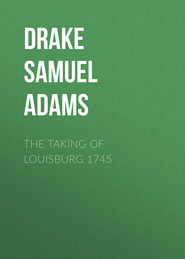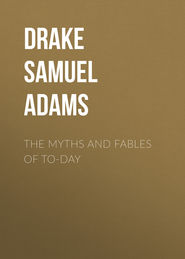По всем вопросам обращайтесь на: info@litportal.ru
(©) 2003-2024.
✖
The Battle of Gettysburg 1863
Настройки чтения
Размер шрифта
Высота строк
Поля
Reynolds immediately sent Buford back to Gettysburg, in order, if possible, to head off the enemy before he should reach that place, for which he was evidently making. A courier was also despatched to headquarters. This was the first trustworthy intelligence of Lee's movement to the east that Meade had thus far received. Could the enemy be massing on his left? It certainly looked like it. After this night there was only one word on the tongues of all men in that army – Gettysburg! Gettysburg!
Reynolds marches up.
The First Corps, also marching for Gettysburg, went into camp some five miles short of that town; the Eleventh lay at Emmettsburg; the Third at Taneytown. It is with them alone that we shall have to deal in what follows.
Positions, June 30th.
Pipe Creek.
We have already seen that Meade had not designed advancing one step farther than might be found effectual for turning Lee back from overrunning the State. This was the first great object to be attained. And this had now been done. To avoid being struck from behind, Lee had been forced to halt, face about, and look for a place to fight in. When the enemy should be fairly in motion southward, Meade meant to take up the position along Pipe Creek, and await an attack there. But he no longer had the disposing of events. In order to gain this position now, Reynolds must have fallen back one or two marches; nor could Meade know that Lee was then coming half way to meet him; or that – strange confusion of ideas! – Lee had promised his generals not to fight a pitched battle except on ground of his own choosing; certainly not on one his adversary had chosen for him; least of all where defeat would carry down with it the cause of the Southern Confederacy itself.
Reynolds.
Reynolds, therefore, held the destinies of both armies in his keeping on that memorable last night of June. He now knew that any further advance on his part would probably result in bringing on a combat – a combat, moreover, in which both armies might become involved, for his military instinct truly foreshadowed what was coming. There was still time to fall back on the main army, to avoid an engagement. But Reynolds was not that kind of general. He was the man of all others to whom the whole army had looked in the event of Hooker's incapacity from any cause, as well as the first whom the President had designed to replace him. He now shared Meade's confidence to the fullest extent. He was a soldier of the finest temper, a Pennsylvanian, like Meade himself, neither rash on the one hand, nor weighed down by the feeling that he or his soldiers were overmatched in any respect on the other. To him, at least, Lee was no bugbear. Having come there expressly to find the enemy, he was not going to turn his back now that the enemy was found. Reynolds was, therefore, emphatically the man for the hour. He knew that Meade would support him to the last man and the last cartridge. He fall back? There was no such word in Reynolds' vocabulary. His order was "Forward!"
So history has indissolubly linked together the names of Reynolds and of Gettysburg, for had he decided differently there would have been no battle of Gettysburg.
Thus it was that all through the silent watches of that moonlit summer's night the roads leading to Gettysburg from north and south, from east and west, were lighted up by a thousand camp-fires. Without knowing it, the citizens of that peaceful village were sleeping on a volcano.
V
THE FIRST OF JULY
Buford.
Since early in the afternoon of June 30th, the inhabitants of Gettysburg had seen pouring through their village, taking position on the heights that dominate it, and spreading themselves out over all the roads leading into it from the west and north, squadron after squadron of horse, dusty and travel-stained, but alert, vigilant, and full of ardor at the prospect of coming to blows with the enemy at last.
This was a portion of that splendid cavalry which, under the lead of Pleasonton, Buford, Gregg, and Kilpatrick, at last disputed the boasted superiority of Stuart's famous troopers. At last the Union army had a cavalry force. These men formed the van of that army which was pursuing Lee by forced marches for the purpose of bringing him to battle.
Oak Ridge.
Willoughby Run.
Forewarned that he must look for the enemy to make his appearance on the Chambersburg and Carlisle roads,[33 - Buford's information was quite exact. "June 30, 10.30 P.M. I am satisfied that A. P. Hill's corps is massed just back of Cashtown, about nine miles from this place. Pender's division of this corps came up to-day, of which I advised you. The enemy's pickets, infantry and artillery, are within four miles of this place, at the Cashtown road." —Buford to Reynolds.] and feeling that there was warm work ahead, Buford was keeping a good lookout in both directions. To that end he had now taken post on a commanding ridge over which these roads passed first to Seminary Ridge, and so back into Gettysburg. First causing his troopers to dismount, he formed them across the two roads in question in skirmishing order, threw out his vedettes, planted his horse-artillery, and with the little valley of Willoughby Run before him, the Seminary and Gettysburg behind him, and the First Corps in bivouac only five miles away toward Emmettsburg, this intrepid soldier calmly awaited the coming of the storm, conscious that if Gettysburg was to be defended at all it must be from these heights.
A pretty little valley was this of Willoughby Run, with its green banks and clear-flowing waters, its tall woods and tangled shrubbery, so soon to be torn and defaced by shot and shell, so soon deformed by drifting smoke and the loud cries of the combatants.
The night passed off quietly. Nevertheless, some thirty thousand Confederates, of all arms, were lying in camp within a radius of eight miles from Gettysburg. Their vanguard had discovered the presence of our cavalry,[34 - Colonel Chapman Biddle puts the Confederate force in camp around Cashtown or Heidlersburg, each eight miles from Oak Ridge, at thirty-five thousand of all arms; perhaps rather an over-estimate of this careful writer.] and was waiting for the morning only to brush it away.
Heth comes down the Pike.
Next morning Heth's division was marching down the Chambersburg pike, looking for this cavalry, when its advance fell in with Buford's vedettes. While they halted to reconnoitre, these vedettes came back with the news that the enemy was advancing in force, infantry and artillery filling the road as far as could be seen. Warned that not a moment was to be lost, Buford at once sent off word to Reynolds, who, after ordering the First Corps under arms, and sending back for the Eleventh, himself set off at a gallop for Gettysburg, followed only by his staff.
He drives Buford.
Buford's bold front had thus caused the enemy to come to a halt; but soon after nine, supposing he had to do with cavalry alone, Heth deployed his skirmishers across the pike, forming his two leading brigades at each side of it; these troops then pushed forward, and soon the crack of a musket announced that the battle of Gettysburg had begun.
Wadsworth comes to Buford's Aid.
After an hour's stubborn fighting, Buford was being slowly but surely pushed back over the first ridge, when a column of the Union infantry was seen coming up the Emmettsburg road at the double-quick. It was Wadsworth's division arriving in the nick of time, as the enemy's skirmishers, followed by Archer's brigade, were, even then, in the act of fording the run unopposed, and unless promptly stopped would soon be in possession of the first range of heights. It was really a neck-and-neck race to see who would get there first.
Reynolds forms the Division.
Charge of the Iron Brigade.
Reynolds falls.
Reynolds was impatiently awaiting the arrival of his troops, who were making across the fields for the ridge he was so desirous of holding on the run. It was plain as day that he had determined to contest the enemy's possession of Gettysburg here. Cutler's brigade was the first to arrive. Hurrying this off to the right of the pike, where it formed along the crest of the ridge under a shower of balls, Reynolds ordered the next, as it came up, to charge on over the ridge in its front, and drive Archer's men out of a wood that rose before him crowning the crest and running down the opposite slopes. It was done in the most gallant manner, each regiment in turn breaking off from the line of march to join in the charge under the eye of Reynolds himself, who, heedless of everything except the supreme importance of securing the position, rode on after the leading regiment into the fire where bullets were flying thickest. Not only was the enemy driven out of the wood, but back across the run, with the loss of about half the brigade, including Archer himself. At the very moment success had crowned his first effort, Reynolds fell dead with a bullet in his brain.[35 - His horse carried him a short distance onward before he fell. His body was carried to the rear, in a blanket, just as Archer was being brought in a prisoner.]
Evil Consequences.
Nothing could have been more unfortunate at this time. With Reynolds fell the whole inspiration of the battle of Gettysburg, but, worst of all, with his fall both the directing mind and that unquestioned authority so essential to bring the battle to a successful issue vanished from the field. He had been struck down too suddenly even to transmit his views to a subordinate. Disaster was in the air.
Cutler is driven.
This dearly bought success on the left was more than offset by what was going on at the right, where Davis' Confederate brigade, after getting round Cutler's flank, was driving all before it. Cutler had to fall back to the Seminary Ridge in disorder.
Having so easily cleared this part of the line, Davis' men next threw themselves astride the ridge, and seeing nothing before them but Hall's battery, which was then firing down the Chambersburg pike, they came booming down upon the guns, yelling like so many Comanche Indians. Before the battery could be limbered up the enemy were among the guns, shooting the cannoneers and bayoneting the horses. It was finally got off with the loss of one of the pieces.[36 - When attacked in this way a battery is at the mercy of its assailants.]
This success put the enemy in possession of all the Union line as far down as the pike, and threatened that part just won with a like fate. We had routed the enemy on the left, and been routed on the right.
The Ridge recovered.
Davis in a Trap.
Fortunately, the Sixth Wisconsin had been left in reserve near the Seminary a little earlier, and it was now ordered to the rescue. Colonel Dawes led his men up on the run. This regiment, with two of Cutler's that had turned back on seeing the diversion making in their favor, drove the enemy back again, up the ridge, to where it is crossed by a railroad cut, some two hundred yards north of the pike. To escape this attack most of them jumped down into the cut; but as the banks are high and steep and the outlet narrow, this was only getting out of the frying-pan into the fire, since while one body of pursuers was firing down into them from above, still another had thrown itself across the outlet and was raking the cut from end to end. This proved more than even Davis' Mississippians could stand, and though they fought obstinately enough, all were either killed, taken, or dispersed.
Heth brought to a Standstill.
Heth's two attacking brigades having thus been practically used up after a fierce conflict, not with cavalry alone, with whom they had expected to have a little fun, but with infantry, in whom they recognized their old antagonists of many a hard-fought field, and who fought to-day with a determination unusual even to them, Heth hesitated about advancing to the attack again in the face of such a check as he had just received, without strong backing up; but sending word of his encounter to Lee, he set about forming the fragments of the two defeated brigades on two fresh ones, where they could be sheltered from the Union fire.
Yet Hill, his immediate chief, had told him only the night before there was no objection in the world to his going into Gettysburg the next day.
This success also enabled Doubleday[37 - General Abner Doubleday succeeded to the command of the First Corps on Reynolds' death.] to reform his line in its old position. The troops on the left had not been shaken, and Cutler's men were now coming back to the front eager to wipe out the disgrace of their defeat.
If the enemy's van had not been without cavalry to clear its march, Heth must inevitably have got into Gettysburg first. As it was, the unexpected resistance he had met with made Heth cautious. Lee's orders to his lieutenants were not to force the fighting until the whole army should be up. Pender was therefore forming behind Heth, the artillery set at work, and all were impatiently looking out for Rodes' appearance on the Carlisle (or Mummasburg) road, before renewing the action.
Eleven o'clock.
This proved a most fortunate respite to the small Union force on Oak Ridge, as, in consequence of it, – the state of things just pointed out, – some hours elapsed before there was any more fighting by the infantry, though the artillery kept up its annoying fire. Meanwhile the two remaining divisions of the First Corps came on the ground. Robinson's was left in reserve at the Seminary, with orders to throw up some breastworks there; Doubleday's, now Rowley's, went into line partly to the right and partly to the left of the troops already there, thus extending both flanks considerably; and at the extreme left, which was held by Biddle's brigade, two companies of the Twentieth New York were even thrown out across the run, into the Harman house and out-buildings, where they did good service in keeping down the enemy's skirmish fire.[38 - The First Corps finally held a line of about a mile and a half, from the Hagerstown to the Mummasburg road.]
Rodes on Union Flank.
Meantime, also, Pender's division had got into line. When formed for the attack it considerably outflanked the Union left. And a little later Rodes was seen coming down the Mummasburg road, or out quite beyond the right of the First Corps. Clearly, the combat just closed was child's play in comparison with what was about to begin.
Oak Hill seized.
These troops gave notice that they were shortly coming into action by opening a sharp cannonade from Oak Hill, the commanding eminence situated just beyond and in fact forming a continuation of Oak Ridge, where the First Corps stood, though separated from it somewhat.











